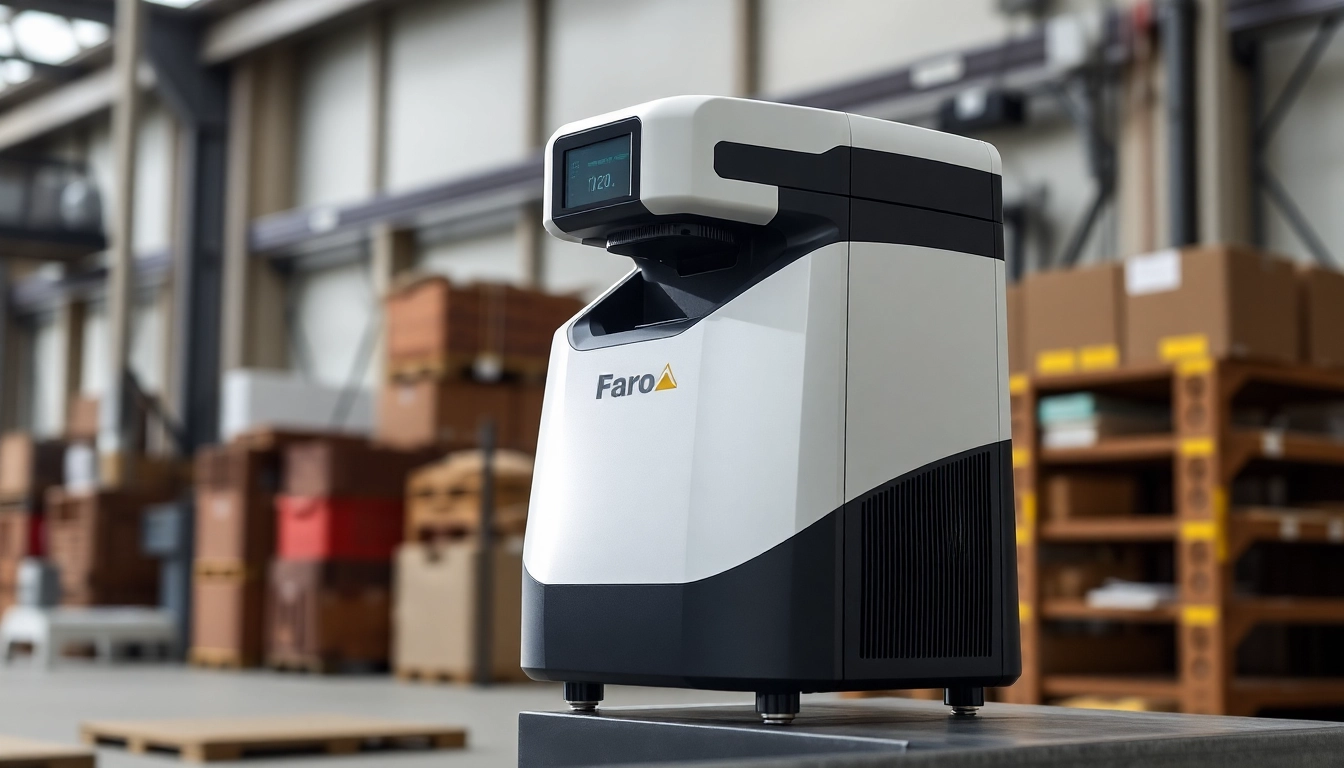Understanding the Faro Focus S150 Laser Scanner
The Faro Focus S150 Laser Scanner represents the cutting edge in 3D laser scanning technology, providing professionals across various industries with precision and reliability. This scanner is built for a myriad of applications, from architectural modeling to construction site analysis. For those interested in acquiring one, a Brand New Faro Focus S150 Laser Scanner For Sale can be a game-changer in terms of elevating productivity and accuracy.
Key Features of the Brand New Faro Focus S150
The Faro Focus S150 is equipped with an array of advanced features designed to enhance the scanning experience. Some of its standout characteristics include:
- High Precision: The scanner delivers incredibly detailed laser scans with a remarkable accuracy of up to 2 mm at a range of 50 meters.
- Fast Scanning Speed: With the ability to capture up to 976,000 measurements per second, users can complete projects faster without compromising on detail.
- Lightweight and Portable: Weighing just around 5.1 kilograms, the Faro Focus S150 is designed for ease of transport, making it a practical option for fieldwork.
- Battery Operated: The built-in battery enables extended use in remote locations without the need for a stable power supply.
- User-Friendly Interface: The intuitive graphical interface simplifies operations, making it accessible for both experienced users and newcomers.
Benefits for Different Industries
The versatility of the Faro Focus S150 allows it to cater to a wide variety of industries, each of which can exploit its technological advantages:
- Architecture: Architects can benefit from accurate 3D models for design visualization, assisting in both modern constructions and renovations.
- Construction: Project managers utilize laser scanning for site scanning and verifying project plans against as-built conditions, reducing discrepancies.
- Manufacturing: In manufacturing, the scanner plays a pivotal role in quality control processes, ensuring that products meet precise specifications.
- Surveying and Mapping: Surveyors use it to collect geospatial data rapidly, creating digital elevation models and topographical maps.
Comparative Analysis with Other Models
When comparing the Faro Focus S150 with other models, several factors come into play:
- Faro Focus S150 vs. S70: While both models are from Faro, the S150 offers greater range and accuracy, making it suitable for larger projects.
- Faro Focus S150 vs. Leica RTC360: Although Leica’s model boasts superior speed, the S150 provides excellent value and ease of use at a more competitive price point.
- Faro Focus S150 vs. Trimble X7: The X7 excels in automatic registration, but the S150 is lighter and more portable, an advantage for fieldwork.
Applications of the Faro Focus S150 in Real-World Scenarios
Architectural Modeling and Heritage Preservation
The Faro Focus S150 is an invaluable tool in architecture, particularly in the areas of modeling and preservation. By creating precise 3D models, architects can better visualize their projects and make adjustments before construction begins. For heritage sites, detailed scans ensure that historical buildings are preserved accurately during renovations.
Construction and Engineering Solutions
Construction firms leverage the Faro Focus S150 for on-site analysis and verification. By comparing as-built scans with design models, teams can identify potential issues early, ensuring that projects stay on schedule and within budget. Its fast and accurate data capture allows for rapid decision-making, which is critical in the competitive construction sector.
Manufacturing and Quality Control
In manufacturing, the importance of quality control cannot be overstated. The Faro Focus S150 enables detailed inspections and measurements of components, ensuring they meet design specifications. By integrating this scanner into their processes, manufacturers can significantly reduce waste and improve overall production efficiency.
Setting Up Your Faro Focus S150 Laser Scanner
Installation and Configuration Steps
Setting up the Faro Focus S150 is designed to be straightforward. Here are the essential steps:
- Unbox and Inspect: Carefully unbox the scanner and check for any visible damage or missing components.
- Charge the Battery: Ensure the battery is fully charged before starting your first scan, utilizing the provided power adapter.
- Install Software: Download and install the FARO Scene software onto your workstation, which is essential for processing the data captured by the scanner.
- Calibrate the Scanner: Follow the calibration protocol outlined in the user manual to ensure optimal scanning accuracy.
- Perform Initial Tests: Conduct initial scans to familiarize yourself with the operation of the scanner and software.
Calibration Techniques for Accurate Results
Calibration is critical to achieving precise measurements with the Faro Focus S150. Users should routinely perform the following calibration techniques:
- Distance Calibration: Use targets placed at known distances to verify distance accuracy and adjust if needed.
- Level Calibration: Ensure the scanner is levelled during use, especially for large-scale scans, to avoid distortion.
- Environmental Considerations: Be aware of factors like temperature and humidity that could affect calibration; conduct tests in similar conditions regularly.
Common Challenges and Solutions in Setup
While setting up the Faro Focus S150 is relatively simple, users may encounter common challenges, including:
- Difficulty with Software Installation: Ensure that your computer meets the software’s system requirements and that all drivers are updated.
- Battery Issues: If the battery does not hold charge, inspect connectivity and consider contacting support for replacement options.
- Access Issues in Tight Spaces: Employ tripods or scaffolding to stabilize the scanner in confined areas to ensure that scanning angles are optimal.
Maintenance and Best Practices for the Faro Focus S150
Regular Maintenance Checklists
Maintaining your Faro Focus S150 is crucial for its longevity and performance. Regular maintenance should include:
- Cleaning the scanner lens with a microfiber cloth to prevent obstructions in scanning quality.
- Checking battery and power connections for signs of wear and tear.
- Performing software updates to incorporate the latest features and improvements.
Software Updates and Troubleshooting Tips
Keeping your scanning software updated ensures that you’re using the latest features and patches. Here are some troubleshooting tips:
- Reinstall the software if it becomes unresponsive or fails to launch.
- Consult the online forums and FAQs provided by FARO for common issues and resolutions.
- Document error messages for accurate reporting if you contact customer support.
Maximizing Efficiency During Use
To maximize efficiency while using the Faro Focus S150, consider the following practices:
- Plan Your Scans: Before arriving on-site, determine the best scanning strategy to minimize time and maximize coverage.
- Utilize Targets: Placing targets can significantly enhance the alignment and registration of scans during processing.
- Post-Processing Training: Spend time honing your skills in post-processing to ensure data quality and reliability.
Why Invest in a Brand New Faro Focus S150 Laser Scanner
Return on Investment for Businesses
Investing in a Faro Focus S150 Laser Scanner can yield significant returns given the efficiencies it introduces. Businesses often experience:
- Reduced time in project deliverables due to faster scanning and processing times.
- Increased accuracy in designs and monitoring which leads to lesser rework costs.
- Improved competitive edge in bids thanks to robust and precise proposals backed by data.
Testimonials from Users and Experts
User testimonials provide insight into how the Faro Focus S150 enhances workflows:
“The accuracy and speed of the S150 have transformed how we approach our projects. It’s become an essential part of our toolkit.” – A satisfied Construction Manager
Future Trends in Laser Scanning Technology
Looking forward, the landscape of laser scanning technology is evolving rapidly. Key trends include:
- Integration with Artificial Intelligence: AI algorithms will enhance data processing, allowing for greater automation and insights.
- Compatibility with AR/VR: Enhancements in augmented and virtual reality will provide immersive experiences for design reviews and presentations.
- Miniaturization and Accessibility: Future models may become even more portable and user-friendly, catering to a broader range of industries.



